
“The Shure MoveMic wireless microphone system is a good way to get great audio from your phone, without wires, making it ideal for new content creators.”
- Quick and easy setup
- Compact microphones
- Flawless Bluetooth connection
- Eight hours of battery life
- Effective noise reduction
- Receiver is essential for third-party apps
- Third-party apps may not be reliable
- Shure’s apps are poorly designed
- No option to buy a single microphone
If you make videos or want to start making videos for YouTube using a smartphone, you’ll likely know that video quality isn’t much of a problem these days. However, getting the audio right is much more difficult. And great sound is essential if you want to have a chance of success. Your phone’s built-in microphone won’t cut it, and cables are very annoying. You want something wireless.
The solution may come from Shure with its new MoveMic microphone system, which provides simple wireless audio from a pair of mics that use Bluetooth to connect to your phone or camera. Should you invest, and will it help launch your YouTube career? We’ll dig into all that in this review.
What is the Shure MoveMic Microphone System?
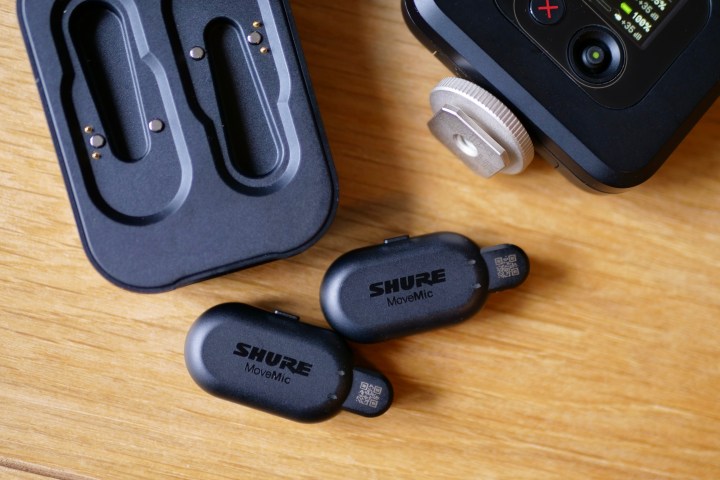
Designed to be a discrete and simple wireless microphone system, the Shure MoveMic is available in several different packages. But is it simple? Well, mostly, but we do need to go through the packages available first, as there is an important decision to be made right from the start.
Shure gives the option of buying the MoveMic One (which has a single microphone included) or the MoveMic Two (with two microphones for dual-channel audio recording). The second option is ideal for interviews, of course. They come in a wireless earbud-style case with its own battery inside. Expect to get eight hours on a single charge from the microphone’s battery and a further two complete charges from the case. Purchased like this, the MoveMic connects to your phone by Bluetooth and are operated using the Shure Motiv Audio or Motiv Video app.
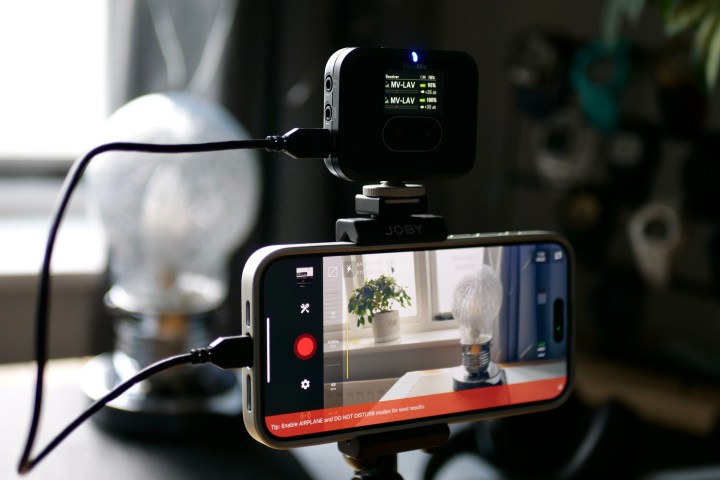
The third option is to buy the MoveMic Two package with a dedicated receiver, which connects to your phone using a USB-C cable. The microphones then connect via Bluetooth to the receiver and are controlled using the onboard screen. This is where you need to make that big decision, as if you want to record audio using a specific app that’s not made by Shure, you must use the receiver; when the MoveMic’s are connected using Bluetooth to your phone, you can only use Shure’s apps to record video and audio.
The microphones are identical regardless of the package you buy and weigh just 8.2 grams each. They have a spring-loaded clip to attach it to a shirt, lapel, or any other item of clothing. The mics are about the same size as a small USB thumb drive, and have an IPX4 water resistance rating, so they’re inconspicuous and durable enough to be worn outside clothing in the rain. They record 24-bit audio.
Setting up the Shure MoveMic
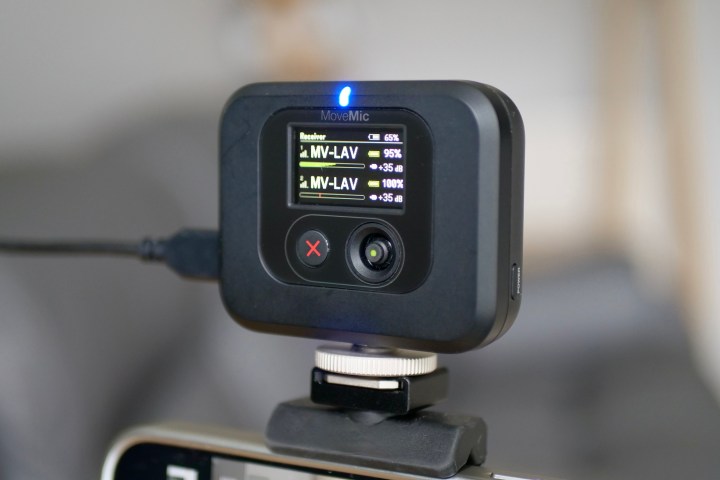
I’ve been using the dual-channel MoveMic Two with the receiver and I was really impressed with just how simple it is to get started. Everything you need is included in the pack — mics, receiver, and USB cables — and connecting them together to the receiver using Bluetooth takes just a few seconds and a couple of button presses.
I’ve been using the mics with an Apple iPhone 15 Pro Max, and after plugging in the receiver’s USB C cable and opening the Motiv Audio app, I was almost immediately began recording audio. To get to this point after opening the box took probably less than 10 minutes worth of effort, outside of charging the devices. It’s even faster still when you don’t have to pair the mics.
The Shure MoveMic system make recording audio very easy and fast.
Once the microphones have been paired with the receiver, they stay paired, so even when they’re put back in the case, all it takes is to power them on, and they automatically reconnect. It’s very convenient and makes on-the-go interview recording really simple. So far, in the short time I’ve been testing the MoveMic, it hasn’t failed to reconnect, indicating it’s a reliable feature. However, if you switch between Bluetooth connection to the app and then to the receiver, the microphones need to be re-paired each time.
The Shure MoveMic system make recording audio very easy and fast, and there are no worries about wasting time with wireless connections, or any concerns about how they will react to changing environments and situations — provided, that is, you stay in the Shure family.
Do you need the MoveMic receiver?

The receiver makes the MoveMic system more expensive, but it may be considered essential by some people. Leaving aside the app compatibility situation for a moment, let’s talk about the receiver on its own. The body has a USB-C port to charge it and connect it to your chosen device, plus a 3.5mm audio out jack and a headphone jack. If you’re using your phone, you have to either use the headphones to hear audio being recorded, and also to hear it played back if you don’t want to remove the USB-C cable.
It’s controlled by two buttons under the small screen, one of which is a tiny joystick used to navigate through the menus. Through the receiver, the mic’s gain can be adjusted, recording modes for speech and singing can be selected, and a high pass filter can be activated with the option for either 75Hz or 150Hz. There is also a noise reduction feature and a full equalizer. Connect two mics and each can be individually muted with a press of the button. The status is also helpfully displayed on the receiver’s screen. The screen also shows live audio monitoring for the microphone.
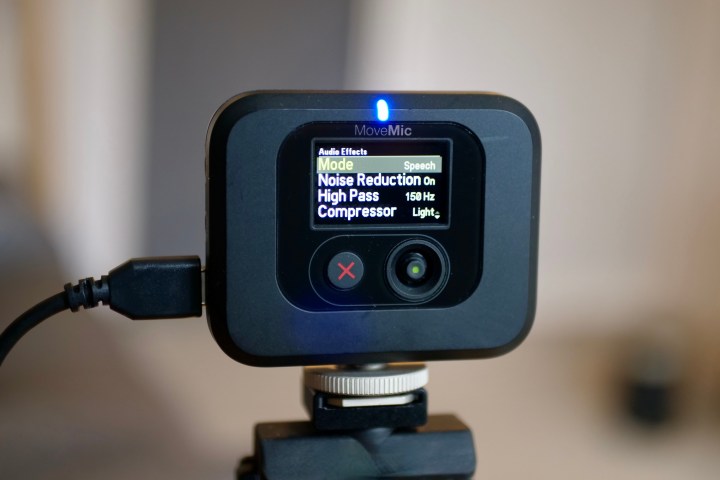
If you really want to go in-depth into tuning your audio recording on the go, you will probably want the receiver. It’s very easy to use, and if you’re recording video with it mounted on a cold shoe, it’ll provide plenty of information at a glance and peace of mind when you’re actually recording. However, I’d recommend getting the package that includes it if you think you’ll want it at some point, as at $199 on its own, it’s an expensive addition later on.
What happens when you don’t use the receiver?
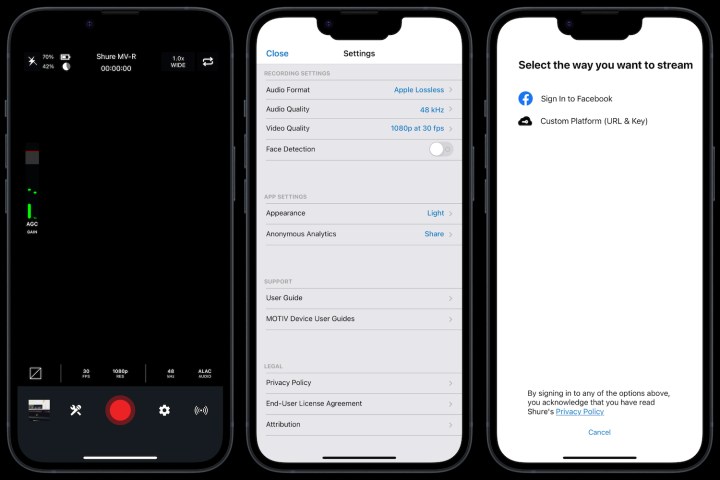
Here’s the big deal about the receiver and whether you’ll need it or not. You can only use Shure’s Motiv Video and Motiv Audio apps if you pair the microphones directly to your phone. Connecting the mics via the receiver using the USB-C cable enables you to use the microphones outside of Shure’s apps.
While Shure’s apps are fine, they aren’t going to satisfy anyone familiar with other apps or who has an established workflow. For example, the Motiv Video app is too slow, and it takes seconds to swap between the main, wide-angle, and telephoto cameras. It’s also a rather messy interface that takes time and effort to learn.
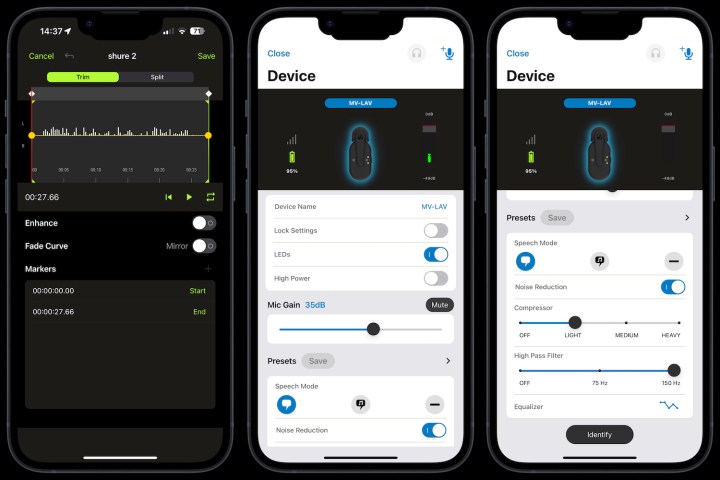
Inside the Motiv Audio app, you can select different recording formats, including WAV, FLAC, Apple Lossless and AAC in various levels of quality, and at up to 24-bit/44.1kHz and 24-bit/48kHz. For reference, a one-minute WAV recording at 24-bit/48kHz is around 17MB. The Motiv Audio app isn’t slow, but design decisions make sharing files frustrating, as the options are hidden under several button taps rather than the single tap in the standard Voice Recorder app.
Forcing the use of Shure’s apps is a very restrictive decision and goes against the concept of the MoveMic being a system for creators and journalists, who will almost certainly want to use other apps. The necessity of using the receiver may end up putting people off the MoveMic due to the additional expense.
How does the MoveMic sound?
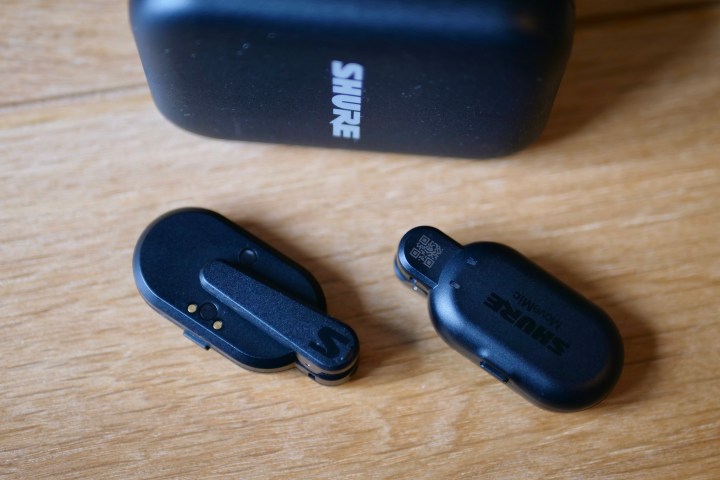
I’ve spoken a lot about how the Shure MoveMic’s work, what they do, and why you may need the receiver, but the most important thing is how they sound. The microphones connect using Bluetooth, and Shure estimates the range to be around 30 meters with line of sight. During my tests, I’ve been able to move freely around my two-level house without any signal or quality drop during the recording.
